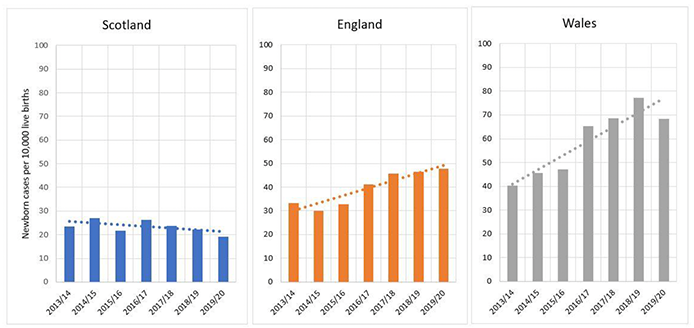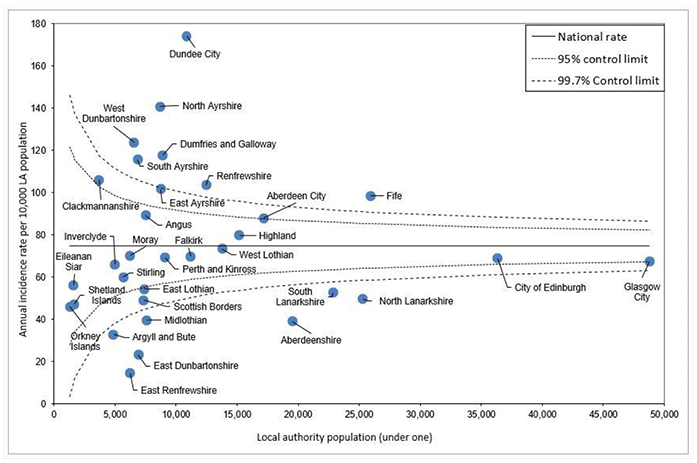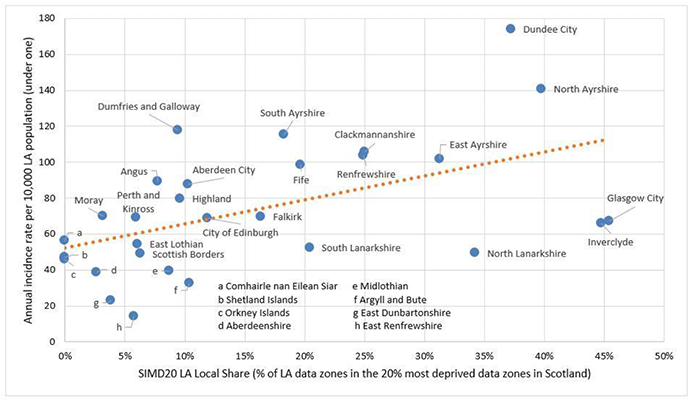Born into care in Scotland: circumstances, recurrence and pathways
The report was commissioned as it is important to understand more about the circumstances in which removal of babies shortly after birth takes place in Scotland, and the work undertaken with parents to prevent separation where possible, and the children’s pathways and permanence outcomes.
4. Infants and newborns becoming looked after in Scotland: scale and trends
This chapter is based on aggregate data extracted from the Scottish Children's Reporter Administration's (SCRA) case management system (CMS), on the numbers of children who became looked after away from home via the Children's Hearings System (CHS), on an Interim Compulsory Supervision Order (ICSO), Compulsory Supervision Order (CSO) or Child Protection Order (CPO). It does not therefore include children who became looked after at home on a CSO, or those looked after under Section 25 of the Children (Scotland) Act 1995 (unless they were later looked after away from home via the CHS). As highlighted earlier, despite the different legal systems in operation, this allows comparison with figures for England and Wales.
Numbers of children becoming looked after and changes over time
Around 14,000 children less than 16 years old became looked after away from home[11] via the CHS in Scotland, on an ICSO, CSO or CPO between 1 April 2013 and 31 March 2020.
Infants (less than a year old) constituted 20% (or 2,849) of these children (see the Appendix for a table of all children looked after away from home via the CHS). This included 882 newborns, who became looked after within a week of birth. The number of newborns becoming looked after fluctuated each year, from 154 in 2014/15 to 96 in 2019/20.
By comparison, a greater proportion of children entering care proceedings in England and Wales do so before they are a year old. In Wales, infants less than a year old constituted 30% of all the approximately 11,000 children entering care proceedings between 2011 and 2018 (Alrouh et al., 2019). In England, this figure was 27% (between 2007/08 and 2016/17) (Broadhurst et al., 2018).
We also considered the proportion of infants (less than a year old) who became looked after away from home as newborns (less than seven days old). In 2013/14 almost a third (31%) of all infants who entered the CHS did so within a week of birth. This remained relatively stable across the period, as can be seen in Table 1.
| Year/ Infant age | 2013/ 14 | 2014/ 15 | 2015/ 16 | 2016/ 17 | 2017/ 18 | 2018/ 19 | 2019 20 | Total |
|---|---|---|---|---|---|---|---|---|
| Newborns | 131 (31%) | 154 (34%) | 119 (27%) | 143 (32%) | 125 (33%) | 114 (30%) | 96 (29%) | 882 (31%) |
| 1 to 3 weeks | 36 (8%) | 47 (10%) | 44 (10%) | 49 (11%) | 41 (11%) | 29 (8%) | 26 (8%) | 272 (10%) |
| 4 to 12 weeks | 53 (12%) | 60 (13%) | 67 (15%) | 58 (13%) | 55 (14%) | 45 (12%) | 47 (14%) | 385 (14%) |
| 13 to 25 weeks | 83 (20%) | 76 (17%) | 61 (14%) | 68 (15%) | 64 (17%) | 68 (18%) | 76 (23%) | 496 (17%) |
| 26 to 52 weeks | 122 (29%) | 117 (26%) | 144 (33%) | 125 (28%) | 95 (25%) | 128 (33%) | 83 (25%) | 814 (29%) |
| Total | 425 (100%) | 454 (100%) | 435 (100%) | 443 (100%) | 380 (100%) | 384 (100%) | 328 (100%) | 2,849 (100%) |
There were no differences between the number of girls and boys becoming looked after away from home, either as infants or newborns.
In England, 43% of infant cases were issued within two weeks of birth[12] in 2013/14, increasing to 51% in 2019/20. In Wales, the figures were 40% in 2013/14 and 51% in 2019/20 (Pattinson et al., 2021). In drawing comparisons, the overall proportion of infants entering care as newborns is lower in Scotland than in both England and Wales, where there is a trend of increasing preference for issuing care proceedings closer to birth.
Incidence rates
Although it is useful to consider the volume, or numbers of infants and newborns becoming looked away from home after via the CHS, this may reflect changes in the population size, namely the number of live births. Therefore, in Table 2, we present the incidence rates for newborns (the number of newborn babies becoming looked after away from home via the CHS in Scotland per 10,000 live births).
| 2013/14 | 2014/15 | 2015/16 | 2016/17 | 2017/18 | 2018/19 | 2019/20 | |
|---|---|---|---|---|---|---|---|
| Incidence rate | 23 | 27 | 22 | 26 | 24 | 22 | 19 |
In 2013/14, for every 10,000 live births, 23 babies became looked after away from home via the CHS before they were a week old. Incidence rates are fairly stable over the period,[13] with 19 newborn cases per 10,000 live births in 2019/20.
Figure 1 shows the incidence rates for Scotland (newborns becoming looked after away from home via the CHS), and comparable incidence rates for England and Wales (newborns entering care proceedings) per 10,000 live births, for the years 2013/14 to 2019/20.[14]

It can be seen that, compared to Scotland where rates were fairly stable, those in both England and Wales were higher, and increased over the period, more steeply for Wales than for England.[15]
Local authority-level variation and the link with deprivation
Previous research has found significant variation between regions and local authorities in the rates of child welfare interventions across the UK, including child protection investigations (Bilson, 2021), care proceedings (Alrouh et al., 2019; Broadhurst et al., 2018; Harwin et al., 2018), and numbers of children in care (Biehal et al., 2019; Bywaters et al., 2015).
To consider variation in incidence rates of infants becoming looked after away from home via the CHS between the 32 local authorities in Scotland, a funnel plot is used (Figure 2). Due to low numbers, this analysis is based on the rates of infants (less than a year old) and combines data for 2013/14 – 2019/20. Funnel plots are a form of scatter plot, in which incidence rates are plotted against population size, by local authority. The straight horizontal line represents the national average, which we would expect most local authorities to fall close to. The dotted lines represent 'control limits', where 95% and 99.7% of the local authorities would be expected to fall, within the inner and outer boundaries of the funnel respectively. If a local authority falls outside the lines, then variation is greater than expected, indicating that the incidence rate departs significantly from the national rate (i.e. an outlier).
It can be seen in Figure 2 that rates of children less than a year old becoming looked after away from home via the CHS varied between 14 infant cases per 10,000 population (less than a year old) to 174 per 10,000, with a national average of 75 per 10,000. Rates for the majority of local authorities fell within the expected boundaries of the national average. Seven local authorities – North and South Lanarkshire, Midlothian, Aberdeenshire, Argyll and Bute, East Dunbartonshire and East Renfrewshire – had rates significantly lower than the national average (i.e. were outliers falling outside the lower control limit). Seven local authorities – Dundee City, North Ayrshire, West Dunbartonshire, Dumfries and Galloway, South Ayrshire, Renfrewshire and Fife – had rates higher than we would expect (i.e. were outliers falling outside the upper control limits).

One possible explanation for the variation in incidence rates is the level of area-level deprivation in different local authorities. The relationship between local deprivation and incidence rates for infants less than a year old becoming looked after away from home via the CHS (again based on combined data for 2013/14 – 2019/20) is shown in Figure 3. Each dot represents one local authority, and plots the incidence rate of infants (less than a year old) becoming looked after away from home via the CHS against local deprivation or SIMD20 'local share' (the proportion of data zones in each local authority that are among the 20% most deprived in Scotland). The line shows that in general, local authority rates of infants looked after away from home via the CHS increase in line with increasing levels of area-level deprivation, although the relationship is complex.

This finding of a relationship between local rates of children looked after and deprivation is consistent with the findings of other UK studies (Bywaters et al., 2015, 2019; Doebler et al., 2021; Hooper et al., 2017). That some local authorities with relatively high levels of deprivation have lower than expected rates of infants becoming looked after away from home via the CHS, and vice versa, suggests that other factors are also at play, including variations in professional practice, availability of preventative services and the implementation of pre-birth guidance and policy. Drawing on the views of 160 decision makers in the Permanently Progressing study, Whincup et al., (2019) found that the way the already complex legislation is used varied across Scotland, with decisions influenced by local systems, cultures and processes. Other factors, such as geographical size and rurality of local authorities, the level of community support or inter-connectedness of families, and ethnic or cultural variations also need to be considered here.
Key findings
- 20% (2,849) of all children less than 16 years old who became looked after away from home via the Children's Hearings System in Scotland between 1 April 2013 and 31 March 2020 were infants less than a year old. This compares to 27% of children entering care proceedings in England and 30% in Wales.
- Almost a third of infants entered the CHS as newborns (less than seven days old), and this remained relatively stable between 2013/14 and 2019/20.
- The overall proportion of infants who enter care as newborns cases is lower than in England and Wales, where there is a trend over recent years towards issuing care proceedings closer to birth.
- In 2013/14, for every 10,000 births in Scotland, 23 babies entered the CHS within seven days of birth, with rates fairly stable between 2013/14 and 2019/20. In comparison, rates in England and Wales were higher and increased over the same period.
- There was considerable variation in the rates of infants less than a year old who entered the CHS in the 32 Scottish local authorities (between 2013/14 and 2019/20), ranging from 14 per 10,000 infants in the local population to 174 per 10,000.
- There was a relationship between the level of deprivation and the local rates of infants looked after away from home via the CHS, although this was complex and rates may also be affected by variations in the approaches of local authorities, Children's Hearings and the courts, the availability of preventative and support services, and other factors.
Contact
Email: lorraine.harris@gov.scot
There is a problem
Thanks for your feedback